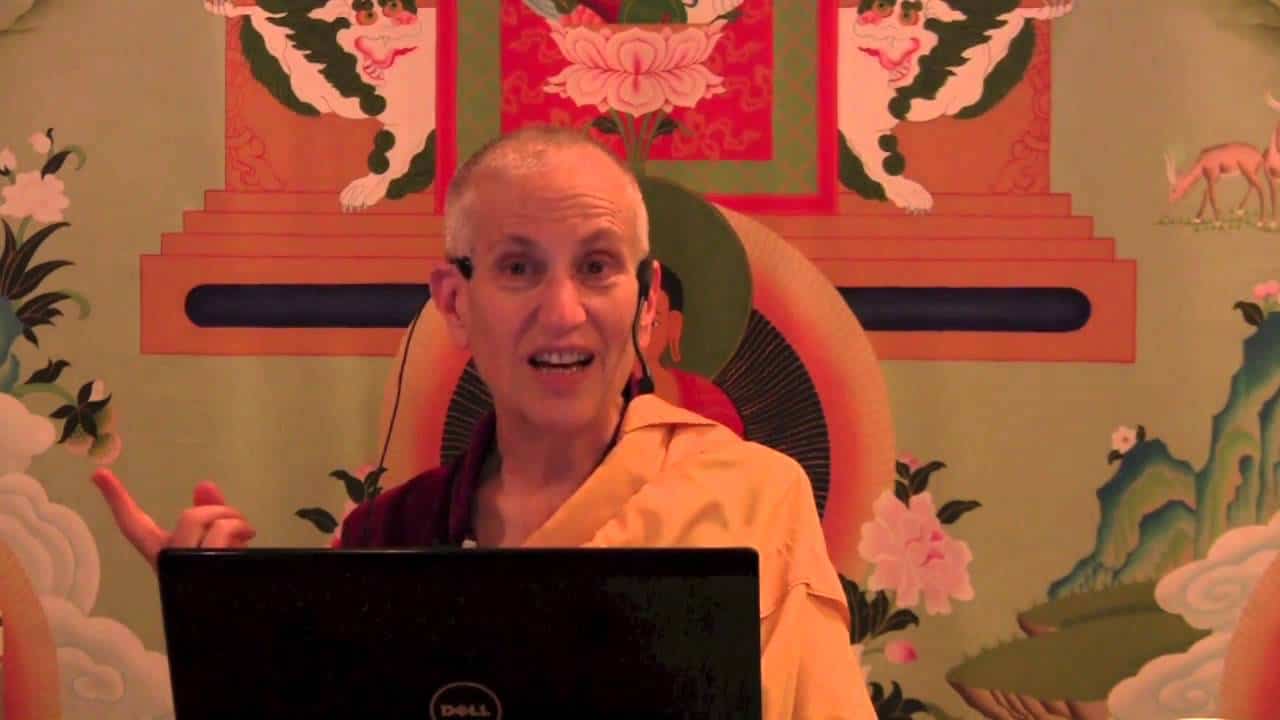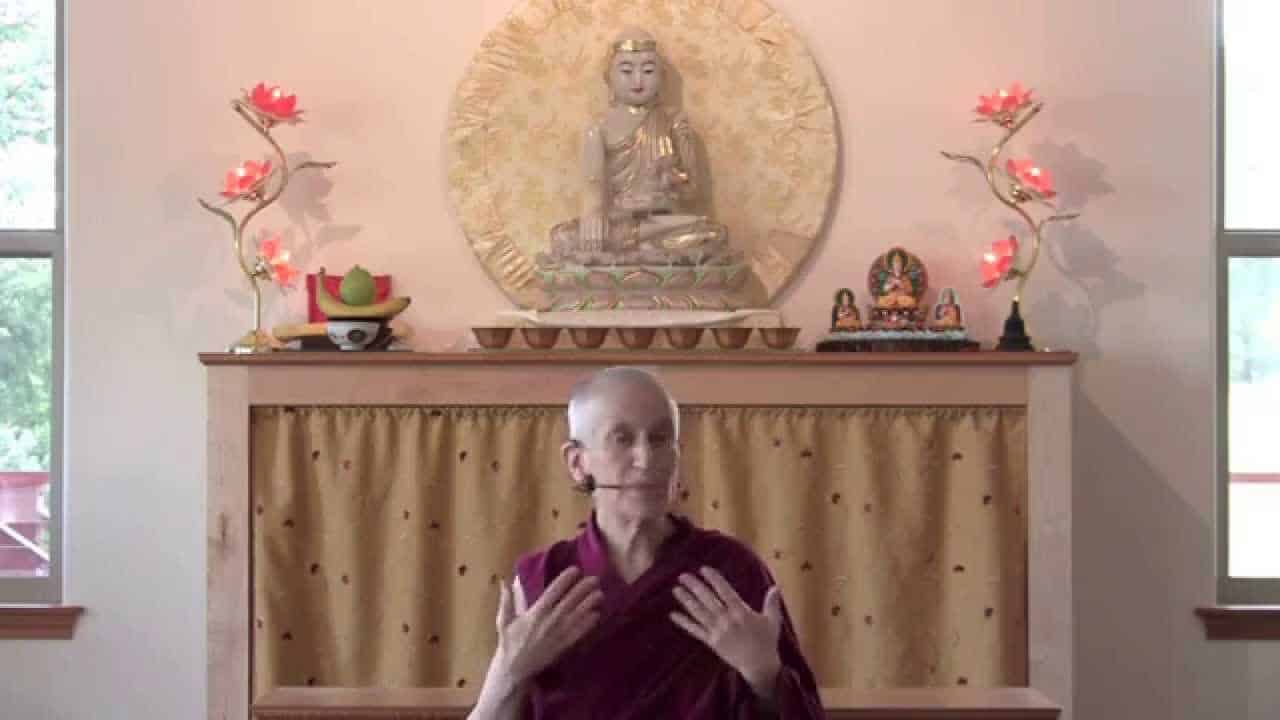Establishing a daily practice
Part of a series of teachings on the text The Essence of a Human Life: Words of Advice for Lay Practitioners by Je Rinpoche (Lama Tsongkhapa).
- Setting our motivation on waking in the morning
- Setting up an altar (shrine)
- Making offerings
- Reflection and meditation
- End of day review
The Essence of a Human Life: Establishing a daily practice (download)
To the Three Jewels make prayers and offerings each day,
work hard to be wholesome, confess previous wrongs,
strengthen your precepts again and again,
dedicating all merit for awakening.
Again, a verse that includes many, many practices synthesized into four lines.
“To the Three Jewels make prayers and offerings each day.” This is a very nice practice, I think. As soon as you get up in the morning take refuge in the Three Jewels. Before you go to bed at night, again take refuge. That helps you really set your direction during the day. Then generate your motivation: “Today I’m not going to harm anybody, I’m going to benefit others as much as possible, and I’m going to strengthen my bodhicitta and have some awareness of emptiness too every day.” Set that kind of motivation every morning. Then get up.
It’s a very nice practice to have a shrine in your home. It’s best not in the bedroom unless that’s the only place you can have it. And not in your office—definitely not in your office—because all the stuff around. If you’re a single person, in your bedroom is okay. If you’re a couple, then better to have the shrine in another room.
You have the Buddha in the central figure. You can put pictures of your teacher above the Buddha. On the Buddha’s right (which is to the left as we look at it) then we have a scripture, usually one of the Prajnaparamita scriptures. On the Buddha’s left (to the right as we look at the shrine) we have a bell or a stupa. The statue of the Buddha represents the body, the scripture the speech, the bell or the stupa the mind of the Buddha. Then if you have photographs or whatever of other deities, these go below the Buddha.
It’s always important to have a buddha in the higher, central part of your altar because everything came from the Buddha. We shouldn’t neglect the Buddha in any way.
Then put offerings in front. In the Tibetan tradition we have the custom of doing the seven offering bowls. I’ve made a video about that, how to think, that’s already online. Put flowers, put fruit. Offer the best quality things you have.
It’s a really nice way to start the day. Get up, and you look at your altar, and there’s the Buddha sitting so peacefully, and you’re mind’s, “Gee I should be like that during the day. And then making offerings part of your daily practice, it’s good, it creates the habit of generosity and takes delight in giving. You just do it early, first thing in the morning, as part of your morning routine, so it’s very easy to do. So we make offerings every morning.
Sit down and do some practice. What we practice is going to differ from one individual to the next. We should choose an appropriate amount of time that we have. Don’t make the sessions too long, but don’t make them too short either. If you have commitments and practices to do every day, make sure you do those, don’t skip them, they’re quite important if you’ve promised your different teachers that you’re going to do them every day.
Also try to take some time for the lamrim meditation. I think these are really crucial to get us thinking about the Buddhist worldview so that our mind really gets adjusted to looking at things in a different perspective, and lamrim is so helpful.
And then, of course, the thought training teachings, to do some reflection on them. They and lamrim, both of them are quite effective for when we’re emotionally upset or just to solve problems that we may encounter during the day, to rely on these teachings. We have to build up familiarity with them before we have the problem. If we only do these meditations when we have a problem, then there’s not going to be any built up familiarity and so it won’t work so much. It’s like…you don’t exercise every day and then you try and pick up a barbell. It’s not going to work. If you exercise every day, then picking up the barbell, you can do it. It’s the same thing with exercising our mind and training it in the Dharma, to do the lamrim and some lojong reflection every day, and then when we have problems, these things work for us. If we don’t do them every day, then we have flabby Dharma muscles, and then they don’t work so well at that time.
Try and go through the day with an awareness of your motivation. Use small things that happen during the day to remind you of your bodhicitta motivation. I find it very helpful at the beginning of the day, in my morning meditation, if I think I’m going to encounter people that I often have difficulties with or situations where my mind often goes quite negative, I try and do a meditation that morning that pertains to that situation or that emotion, again to prepare my mind, get my mind in a good direction.
Periodically throughout the day stop and reflect. I think before eating, since we eat a lot during the day, is a good time to stop, offer our food, reflect on the Three Jewels, reflect on the meaning of our lives. It’s not like you have to do hour-long meditations at this point. Just a short reflection, one minute, two minutes. It’s something that brings your mind back to the Dharma. Very helpful.
In the evening to kind of review the day, do some evaluation about how we did, where we were successful and living according to our motivation, where we goofed up. Rejoicing where we went ahead and created virtue. And in the times when we goofed up to do some purification and look at what it was, what affliction took over our mind, and how that happened. To try and understand the cause of the affliction, the nature of that affliction, and its effect. Those three: the cause, the nature, and the effect. That will help us understand that afflicted state of mind. Then to choose one of the Dharma antidotes to contemplate to remedy that afflicted state of mind.
If we do that, when we go to bed everything is kind of tidy, so to speak. Whereas if we don’t reflect on the day and we don’t process our emotions, then we go to bed, we’re upset, we get up, we’re upset. We go to bed, we’re angry, we get up angry, and that doesn’t help us or anybody else around us. So as much as we can have a rounded daily practice that’s consistent from one day to the next then we really benefit from that.
Of course we see here living at the Abbey it’s very easy to keep a consistent practice because that’s what we’re here for and that’s what everybody else is doing. If you’re not doing it…. You can’t stay here and not do that. It happens automatically that we work on our minds. It becomes quite easy.
When you’re not in this kind of environment then you really have to have a lot of self-discipline. That self-discipline comes through deep Dharma understanding. It is also helpful to just have a regular daily schedule because the more you have a regular daily thing then you build your Dharma practice in as part of that. In that way your practice gets done. Whereas if from one day to the next, one day you get up at 6:00, next day you get up at 8:00, one day you get up and eat breakfast and you’re off, and the next you sit and meditate for four hours…. Doing it like that it’s going to be harder. A little bit consistent every day is really good.
We just got through the first line of this verse: “To the Three Jewels make prayers and offerings each day.” But it kind of sets the stage for a daily practice. We’ll go into the other recommendations in the following days.
Venerable Thubten Chodron
Venerable Chodron emphasizes the practical application of Buddha’s teachings in our daily lives and is especially skilled at explaining them in ways easily understood and practiced by Westerners. She is well known for her warm, humorous, and lucid teachings. She was ordained as a Buddhist nun in 1977 by Kyabje Ling Rinpoche in Dharamsala, India, and in 1986 she received bhikshuni (full) ordination in Taiwan. Read her full bio.


